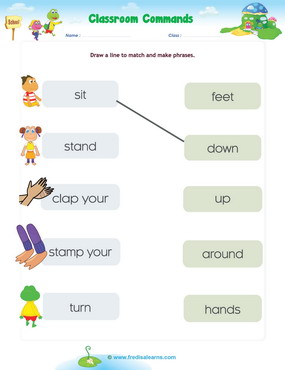Unit 1: Classroom Commands
This is a free lesson sample taken from starter 1 of our course.
Main Lesson Materials & Study Steps
1st –This cartoon animated video features a short dialogue, followed by vocabulary and sentence breakdown. It is essential for introducing the words, phrases, grammar, spelling and sentences of the lesson in context. Watch repeatedly to master the content. The video plays on any device.
2nd – Then the student plays this fun game after watching the video, to practice the contents of the lesson. The game reviews key vocabulary, grammar and sentences from the lessons. This game can be played on any device.
3rd – Finally the learner takes this test of the unit. The score of this test is captured in the LMS and gives educators an idea of how well their learner is doing. The test opens on any device – mobile & PC.
Worksheets for the Unit
The worksheets below are useful for offline and classroom activities. These printable exercises directly correlate with the above lesson 'Classroom Commands'. Every worksheet comes with an answer sheet on the second page for educators.
Objectives:
- Teach ESL/EFL young learners how to understand and respond to different classroom commands.
- Teach essential action verbs that students will need throughout their English study life.
- Learn to give and follow orders using short phrases in the imperative mood.
- Introduce the concept of TPR (Total Physical Response) as a language learning method which will be used very often in future lessons.
Already a Member?
Not a member yet?
Lesson Story:
Miss Ann is teaching students basic classroom commands today.
Vocabulary: |
Key Phrases/Sentences: |
|
|
Integrating Fun and Learning with Commands Games
Learning English as a second language (ESL) can be a daunting task for children. They often struggle to understand and remember new words, phrases, and sentence structures. Classroom commands in English are crucial for maintaining order and facilitating communication between teachers and students. Incorporating commands games into the ESL classroom can make the learning process more enjoyable and effective for children.
Why Are Classroom Commands Important?
Classroom commands are essential for creating a structured and organized learning environment. They help in managing the classroom, maintaining discipline, and ensuring that students are engaged and attentive. For ESL students, learning classroom commands in English is crucial as it helps them understand and follow the teacher's instructions, thereby making the learning process smoother.
The Power of Game-Based Learning
Children naturally love playing games. Games engage their attention, stimulate their imagination, and encourage interaction. Game-based learning leverages this natural inclination by integrating educational content into games. It is an effective way to teach new concepts, reinforce learned material, and assess a child's progress in a fun and interactive manner.
Commands Games: A Fun Way to Learn Classroom Commands
Commands games are an excellent way to teach classroom commands in English to ESL students. These games are designed to help children learn and practice common classroom commands such as "stand up," "sit down," "open your book," "close your door," etc., in an interactive and fun way. Here are some popular commands games that you can incorporate into your ESL classroom:
Simon Says: This is a classic game that can be easily adapted to teach classroom commands. The teacher plays the role of 'Simon' and gives commands to the students. The students must only follow the command if it is preceded by the phrase "Simon says." For example, if the teacher says, "Simon says, open your book," the students must open their book. If the teacher just says, "Close your book," without saying "Simon says," the students must not follow the command.
Command Relay Race: Divide the students into two teams and have them stand in a line. The teacher will say a command, and the first student in each line must perform the action. Once they complete the action, they go to the back of the line, and the next student in line performs the next command given by the teacher. The first team to complete all the commands correctly wins.
Command Bingo: Create bingo cards with different classroom commands written on them. The teacher will say a command, and the students must mark the command on their bingo card if they have it. The first student to mark all the commands on their card and shout "Bingo!" wins.
Benefits of Using Commands Games
Enhanced Retention: Children are more likely to remember classroom commands when they learn them through interactive games.
Improved Listening Skills: Commands games require students to listen carefully to the teacher's instructions, thereby improving their listening skills.
Increased Engagement: Games are fun and engaging, which helps in keeping the students attentive and involved in the learning process.
Promotion of Active Participation: These games encourage all students to participate actively, ensuring that every child is involved in the learning process.
Online Commands Games
In addition to traditional classroom games, there are also online commands games available that can be played on computers or tablets. These online games are interactive and often include visual and auditory cues, making them even more engaging for children. For example, FredisaLearns.com offers a free online game about commands that helps children learn and practice classroom commands in English in a fun and interactive way. You can access the game here.
Incorporating Commands Games into Your Teaching Routine
Incorporating commands games into your ESL teaching routine is quite simple. Start by teaching the students the basic classroom commands in English. Explain the meaning of each command and demonstrate the action associated with it. Once the students have a basic understanding of the commands, you can start playing the games. Be sure to provide clear instructions and offer positive feedback and encouragement throughout the game.
Conclusion
Teaching classroom commands in English is crucial for creating a structured and organized learning environment in the ESL classroom. Commands games are an effective and enjoyable way to teach and practice classroom commands with children. They enhance retention, improve listening skills, increase engagement, and promote active participation. Incorporating traditional and online commands games into your teaching routine can greatly benefit your ESL students.
This lesson is part of the Starter 1 English course for absolute beginners.














